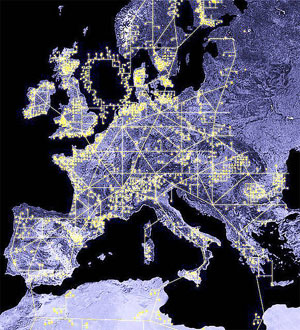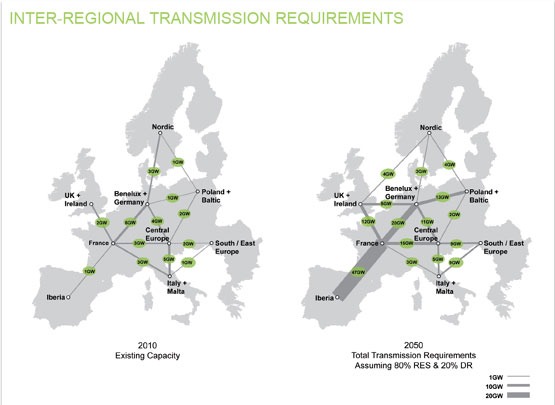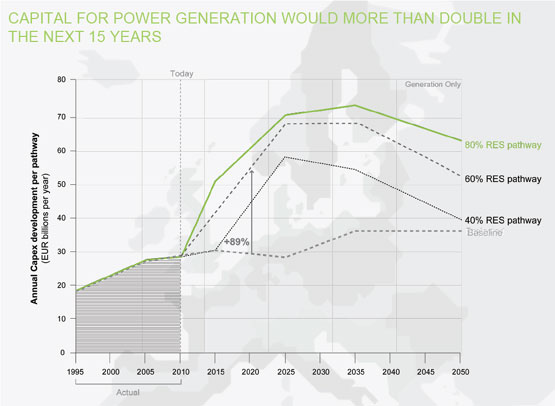A heavy burden on EU policymakers
on
A heavy burden on EU policymakers
“Tout Brussels” gathered on Tuesday for the presentation of the “Roadmap 2050”of the European Climate Foundation (ECF). The ECF’s study – sponsored by companies (among others, RWE, Eon, Siemens) and NGO’s (WWF, GermanWatch) – purports to show that “decarbonising Europe” by 2050 is possible at virtually no extra cost. Provided policymakers take the necessary steps.
 |
| Artist impression of a decarbonised grid for the EU in 2050. Wind energy from the North Sea and the western coastlines as well as solar energy from the south will provide the bulk of our energy. |
In fact, the Roadmap 2050 may be viewed as a gauntlet thrown down to policymakers. Not the first, however. Last year green group Friends of the Earth (FoE) and the Stockholm Environment Institute published a report showing that Europe could cut its emissions by 40% by 2020 at a cost of 2% of cumulative GDP. ‘Our main message is that this is possible,’ Esther Bollendorff from FoE Europe said at the time. ‘[Although] clearly in the current political climate this is not going to happen.’
McKinsey's famous cost abatement curve, originally developed with energy firm Vattenfall in 2007 and updated last year, also carried the clear message that cutting greenhouse gas emissions is cheaper than everyone thinks it is. Global warming can be limited to two degrees Celsius at a cost of around half a per cent of global GDP, the consultancy said in January 2009. This figure was below its previous predictions and is around half UK economist Nicholas Stern's estimate. McKinsey's most important abatement actions, on energy efficiency, come largely at a net profit.
Now comes the latest, and probably biggest gauntlet thrown down to EU policymakers so far: an independent study funded entirely by the ECF that sets out viable, cost-effective scenarios for Europe to cut emissions by 80% by 2050. It comes with a full technical and economic analysis and policy recommendations.
The ECF is a private philanthropic organisation that provides grants to groups consistent with its goal of promoting low-carbon policies in Europe. It is funded by yet other philanthropic organisations: the Children’s Investment Fund Foundation, the Arcadia Fund, the McCall MacBain Foundation, the Oak Foundation, the Sea Change Foundation and the ClimateWorks Foundation.
For its 2050 study, the ECF worked closely with a steering group in which energy, technology and renewables firms were represented as well as NGOs. Its study comes as the European Commission is preparing its own ideas for decarbonisation pathways to 2050, which are to be published in June. Subsequently, the Commission will launch a public consultation for an EU energy and climate strategy for 2050, to be finalised next year. It will also issue a new impact assessment for a 30% EU emission reduction target for 2020, based on its 2050 work.
Hot potatoes
Like the McKinsey work, the ECF study is an economic analysis. This means it stays away from political hot potatoes such as public acceptance. That's for policymakers to grapple with, the authors say. But their study will help determine with what energy and conviction policymakers do so. ‘We're told the biggest barrier to a high renewable energy scenario is economic and we basically found this is not true,’ says Tom Brookes, head of ECF communications. ‘We were also told instability is a big problem and this is also not the case we found.’
The study takes as its starting point EU leaders' stated goal to cut greenhouse gas emissions by 80% by 2050. Its first conclusion is that this requires full decarbonisation of the power sector. This is necessary because reducing emissions in road transport and buildings requires a large degree of electrification of these sectors. The authors ultimately envisage 95% decarbonisation in all three of the sectors.
They initially modelled three pathways – a 40%, 60% and 80% renewables penetration by 2050 – then added a fourth, 100% renewables, when they saw how feasible the first three were. In each case the part not covered by renewables was split between carbon capture and storage (CCS) and nuclear power. CCS is required in particular to achieve significant emission abatements in heavy industry.
Each scenario maintains the grid's current 99% reliability, relies on existing and late-stage technology, and uses only European energy resources – except the 100% scenario, which imports energy from North Africa. This scenario also assumes a breakthrough in geothermal power. No lifestyle changes are assumed under any scenario.
In the study, coal, oil and gas use peaks around now. Solar and wind energy dominate Europe's energy supply in 2050 and most of it comes from Spain. Spain's role as future European energy provider explains the priority given to transmission grid development in the study.
Super-grid
Interconnected national transmission grids, or a European super-grid, is the first of three essentials the ECF names to fully decarbonise the power sector. The other two are energy efficiency and market reform, the latter to ensure the whole transition can be financed.
National grids must be interconnected to allow energy supply and demand to be spread across Europe for maximum efficiency and minimum storage requirements, the ECF says. It assumes some smart grid technology, but is not reliant on it. No new large-scale energy storage is assumed. European energy supply and demand both vary across the bloc and actually fit quite well together as a patchwork quilt, the authors found.
Sun dominates the south and in summer while wind dominates the north and in winter. Imperial College London mapped weather and electricity demand for the first time, breaking the EU into nine regions, and found that combining regional demand curves reduced volatility because people use power in different ways depending on where they are.
 |
In terms of concrete inter-regional requirements, the authors point to a 47 gigawatt (GW) connection between France and Spain in particular. This would be the largest interconnection in Europe and stems from Spain's future role as number one energy provider. Herein lies a first and major problem. It has taken France and Spain 20 years to agree a single power line between them, and this for less than 1GW. You might think it in France's interests to be as interconnected as possible, since it is an energy exporter, but a large connection to Spain could cost it considerable market share. Countries like France must ‘consider wider regional benefits than is currently the case,’ the report reads.
There has also been longstanding local opposition to unsightly electricity pylons cutting across the Pyrenees. But alternative solutions such as underwater cables come with a significantly higher price tag. French energy firm EDF was not involved in the ECF study. GDF Suez and Alstom, a French engineering firm, were involved but did not endorse the final conclusions.
Market reform
Aside from the transmission grid requirements, two to three times the current rate of energy efficiency improvements – 2-3% rather than 1-2% annual efficiency gains – will also be crucial to achieving full decarbonisation, the authors say. Specific policy recommendations include a binding energy efficiency target and incentives beyond the EU emission trading scheme (ETS) to drive efficiency improvements.
The ECF says efficiency gains across Europe will enable its grids, or a future super-grid, to absorb new demand from road transport (electric vehicles) and buildings. Electricity consumption will increase by 40% from today to 2050 under both the baseline and renewables scenarios. The group envisages people charging their electric cars during the day, using solar as the peak management technology, rather than at night, when fossil fuel power dominates. One clear policy implication of this is that an urban charging infrastructure would have to be developed.
Financing the decarbonisation scenarios means Europe will have to double capital expenditure in the power sector in the next 10-15 years. This will require market reform, according to the study. Speaking at the launch of the study, EU energy commissioner Günther Oettinger said finding money for green energy infrastructure would be a ‘hard fight’ in the coming years. It could come from member states, private investors or other EU budget programmes, he suggested. Overall, both the private and public sectors would contribute.
The ECF study predicts that the unit cost of electricity over the 2010-50 period could be 10-15% higher than in the baseline (excluding carbon pricing), but the cost of energy per unit of GDP declines by 20-30% relative to the baseline, due in large part to greater energy efficiency. This equates to a total lower cost of €350bn per year by 2050.
The 10-15% higher costs of renewables in the power sector could be “bridged” by an average CO2 price of €20-30 per tonne, the authors say.
Overall the impact on GDP is muted. ‘There isn't a huge win for the economy nor is there a catastrophe,’ Jeremy Oppenheim from McKinsey, one of the study's partners, said at the launch on Tuesday. ‘The result in macroeconomic terms is relatively buffered.’
The short-term investments required could see a 0.02% reduction in the growth rate of the European economy, but the GDP growth rate could rise by 0.07% above business-as-usual by 2050.
Annual European investments needed amount to 2.5% of total EU spend in the 80% renewables scenario. This compares to 2.8% spent on road infrastructure and 4.6% spent on telecoms. Investments will need to increase from around €28bn per year now to €70bn in 2025 to peak at €74bn in 2035 before dropping back down to €64bn in 2050.
 |
Toughest challenge
The ECF study is the first to map out European decarbonisation to 2050, apart from a study from Eurelectric, the organisation of the European electricity industry, released last November. This study also said that a large-scale shift towards electrical applications in heating and cooling and transport will be essential to decarbonise the power sector. Power sector CEOs committed themselves to achieve a ‘carbon neutral power supply by 2050’ in March last year. This means cutting emissions by 90% by 2050 versus 2005 levels. Domestic emissions would be reduced as far as possible and any ‘unavoidable’ emissions will be offset through emission reduction projects in developing countries.
Like the ECF, Eurelectric also calls for EU policymakers to promote energy efficiency, although it stops short of calling for a binding target, and for incentives to invest in a green energy infrastructure. But its modelling envisages only 38% of power coming from renewables in 2050, less than the most conservative of the ECF scenarios. Renewables groups insisted they could do more.
And they are still insisting on this. ‘Every single industry group complained like hell that we were underestimating what they could deliver,’ one person involved in the ECF project said.
But with the assumptions the study makes, specifically that it works with existing and late-stage technologies, the challenge for the future lies above all with policymakers. EU, national, regional and local policymakers will have to turn the economics that makes sense into politics that makes sense. ‘Arguably the toughest challenge of all is to obtain broad, active public support for the transformation,’ the report concludes. ‘If European leaders are serious about achieving an 80% reduction in GHG emissions by 2050, then a heavy burden falls on policymakers.’
The transition must start in the next five years, the ECF says. Judging by the number of high profile attendees at the ECF report's launch – the European Commissioners for Energy and Climate, the Spanish Climate Minister, the French Energy Minister, and many others – it has gotten off to a good start. Perhaps history will repeat itself.


Discussion (0 comments)